

Compact Muon Solenoid
LHC, CERN
| CMS-PAS-EXO-12-033 | ||
| Search for new physics using boosted Z bosons decaying to electrons in proton-proton collisions at $\sqrt{s} = $ 8 TeV | ||
| CMS Collaboration | ||
| February 2017 | ||
| Abstract: A search for new heavy particles whose two-body decays involve boosted Z bosons is presented, based on the dielectron decay channel, using 19.7 fb$^{-1}$ of $\sqrt{s}= $ 8 TeV proton-proton collision data collected by the CMS detector in 2012. No evidence for non-standard-model physics is observed in the inclusive Z boson transverse momentum spectrum, and upper limits on the cross section for production of excited quarks decaying to qZ are obtained. The analysis excludes, at 95% confidence level, the production of excited quarks decaying to qZ for excited quark masses below 2.6 TeV (3.0 TeV) in gauge (contact) interaction production modes, under the standard assumption of $f=f'=f_s= $ 1. | ||
| Links: CDS record (PDF) ; inSPIRE record ; CADI line (restricted) ; | ||
| Figures | |

png pdf |
Figure 1:
Feynman diagrams for the boosted Z boson signatures of quark compositeness models at the LHC's proton-proton collisions; excited quark production via gauge interactions (left) and contact interactions (right). |

png |
Figure 1-a:
Feynman diagram for the boosted Z boson signatures of quark compositeness models at the LHC's proton-proton collisions: excited quark production via gauge interactions. |
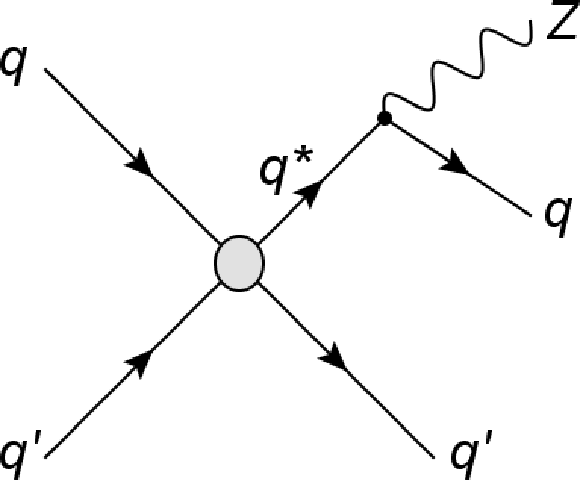
png |
Figure 1-b:
Feynman diagram for the boosted Z boson signatures of quark compositeness models at the LHC's proton-proton collisions: contact interactions. |
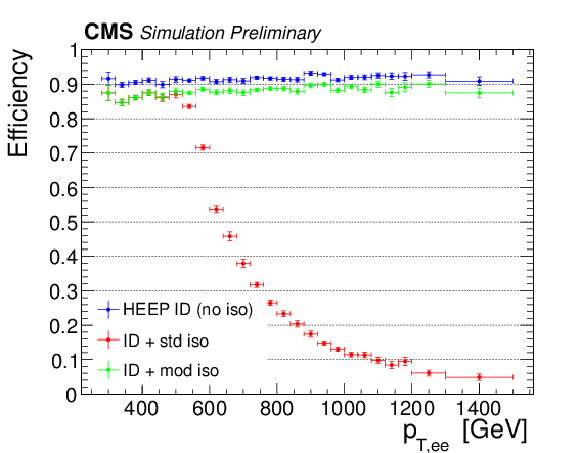
png pdf |
Figure 2:
The efficiency of the electron ID criteria [27] alone, combined with standard isolation and with modified isolation, for reconstructed Z bosons from simulated Drell-Yan events in which both electrons are within acceptance, shown as a function of Z boson transverse momentum. |
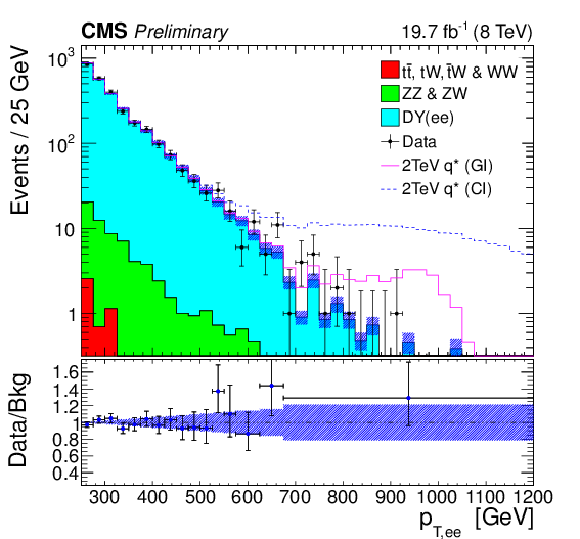
png pdf |
Figure 3:
The predicted and observed transverse momentum spectra of reconstructed Z boson candidates passing selection criteria. In the upper plot, the points with errors bars represent data. The filled histograms show the contributions from standard model processes, as predicted by Monte Carlo simulation; the dark blue hatched band shows the systematic uncertainty on this prediction. The stacked open histograms show the additional contribution from the production of excited quarks (mass 2 TeV) through gauge interactions (GI) and contact interactions (CI). The lower plot shows the ratio of the observed event yield and that expected from standard model processes. All error bars represent the statistical uncertainty on the observed number of events. |
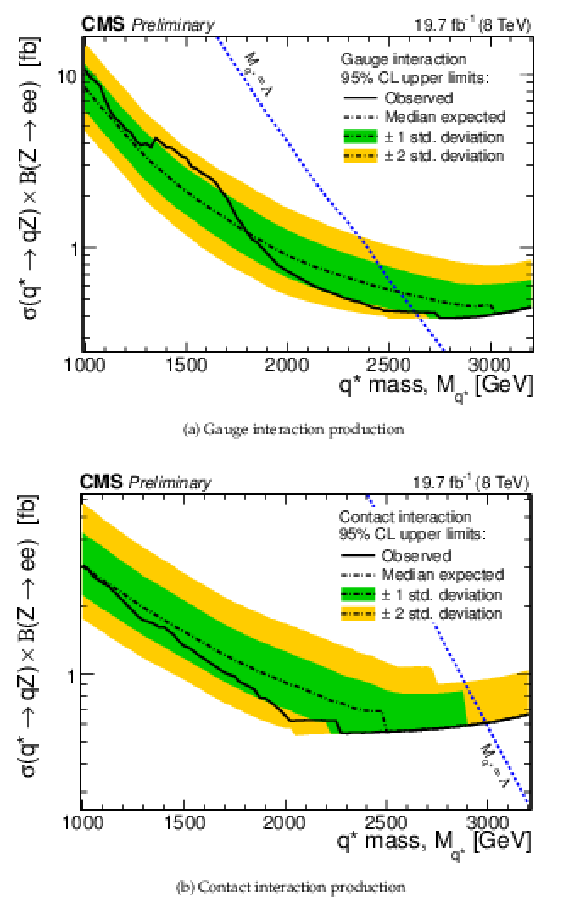
png pdf |
Figure 4:
Upper limits on the product of the excited quark production cross section and branching fraction into dielectron final state, shown as a function of excited quark mass. The dotted-dashed black line shows the median expected limit based on the background-only hypothesis, and the shaded bands correspond to the central 68% and 95% quantiles. The solid black line shows the observed limit, calculated from the full 19.7 fb$^{-1}$ data set. The blue line shows the theoretical excited quark cross section and branching fraction for $f=f'=f_s= $ 1. |
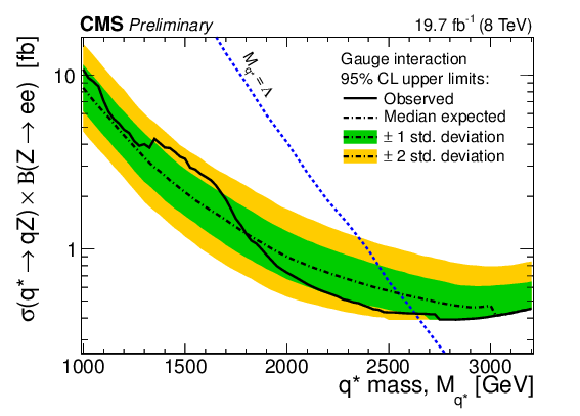
png pdf |
Figure 4-a:
Gauge interaction: Upper limits on the product of the excited quark production cross section and branching fraction into dielectron final state, shown as a function of excited quark mass. The dotted-dashed black line shows the median expected limit based on the background-only hypothesis, and the shaded bands correspond to the central 68% and 95% quantiles. The solid black line shows the observed limit, calculated from the full 19.7 fb$^{-1}$ data set. The blue line shows the theoretical excited quark cross section and branching fraction for $f=f'=f_s= $ 1. |

png pdf |
Figure 4-b:
Contact interaction: Upper limits on the product of the excited quark production cross section and branching fraction into dielectron final state, shown as a function of excited quark mass. The dotted-dashed black line shows the median expected limit based on the background-only hypothesis, and the shaded bands correspond to the central 68% and 95% quantiles. The solid black line shows the observed limit, calculated from the full 19.7 fb$^{-1}$ data set. The blue line shows the theoretical excited quark cross section and branching fraction for $f=f'=f_s= $ 1. |
| Summary |
| A search for new heavy particles whose decays involve boosted Z bosons has been presented, based on the dielectron decay channel, using 19.7 fb$^{-1}$ of $\sqrt{s}= $ 8 TeV proton-proton collision data collected by the CMS detector. The observed Z boson $p_{\mathrm{T}}$ spectrum is consistent with expectations from the standard model, and upper limits have been set on the cross section times branching fraction for the production of excited quarks decaying to qZ. Excited quark production via gauge (contact) interaction mode is excluded at 95% confidence level for masses below 2.6 TeV (3.0 TeV), under the standard assumption of $f=f'=f_s=$ 1. |
| References | ||||
| 1 | U. Baur, I. Hinchliffe, and D. Zeppenfeld | Excited quark production at hadron colliders | Int. J. Mod. Phys. A 02 (1987) 1285 | |
| 2 | U. Baur, M. Spira, and P. M. Zerwas | Excited-quark and -lepton production at hadron colliders | PRD 42 (1990) 815 | |
| 3 | K. T. Matchev and S. D. Thomas | Higgs and $ Z $ boson signatures of supersymmetry | PRD 62 (2000) 077702 | |
| 4 | R. Foadi, M. T. Frandsen, T. A. Ryttov, and F. Sannino | Minimal walking technicolor: Setup for collider physics | PRD 76 (2007) 055005 | |
| 5 | L. Evans and P. Bryant (editors) | LHC machine | JINST 3 (2008) S08001 | |
| 6 | The CMS collaboration | Search for anomalous production of highly boosted Z bosons decaying to $ \mu^+\mu^- $ in proton-–proton collisions at $ \sqrt{s} = $ 7 TeV | Physics Letters B 722 (2013) 28 | |
| 7 | The CDF collaboration | A study of anomalous production of Z bosons with high transverse momentum at the Tevatron | CDF note 8452 (2006) | |
| 8 | The DO collaboration | Measurement of the inclusive differential cross section for Z bosons as a function of transverse momentum in $ \overline{p} $-$ p $ collisions at $ \sqrt{s} = $ 1.8 TeV | PRD 61 (2000) 032004 | |
| 9 | The CMS collaboration | Combination of diboson resonance searches at 8 and 13 TeV | Technical Report CMS-PAS-B2G-16-007, CERN, Geneva | |
| 10 | The CMS collaboration | Search for new resonances decaying to $ \mathrm{WW}/\mathrm{WZ} \to \ell\nu \mathrm{qq} $ | Technical Report CMS-PAS-B2G-16-020, CERN, Geneva | |
| 11 | The CMS collaboration | Search for massive resonances decaying into WW, WZ, ZZ, qW and qZ in the dijet final state at $ \sqrt{s} = $ 13 TeV using 2016 data | Technical Report CMS-PAS-B2G-16-021, CERN, Geneva | |
| 12 | The CMS collaboration | Search for heavy resonances decaying into a $ \mathrm{Z} $ boson and a $ \mathrm{W} $ boson in the $ \ell^+\ell^-\mathrm{q}\bar{\mathrm{q}} $ final state | Technical Report CMS-PAS-B2G-16-022, CERN, Geneva | |
| 13 | The ATLAS collaboration | Search for high-mass resonances decaying into a Z boson pair in the $ \ell\ell\nu\nu $ final state in $ pp $ collisions at $ \sqrt{s} = $ 13 TeV with the ATLAS detector | Technical Report ATLAS-CONF-2016-012, CERN, Geneva | |
| 14 | The ATLAS collaboration | Search for ZZ resonances in the $ \ell\ell qq $ final state in pp collisions at $ \sqrt{s} $ = 13 TeV with the ATLAS detector | Technical Report ATLAS-CONF-2016-016, CERN, Geneva | |
| 15 | The ATLAS collaboration | Search for resonances with boson-tagged jets in 15.5 fb$ ^{-1} $ of $ pp $ collisions at $ \sqrt{s} = $ 13 TeV collected with the ATLAS detector | Technical Report ATLAS-CONF-2016-055, CERN, Geneva | |
| 16 | The ATLAS collaboration | Search for diboson resonance production in the $ \ell\nu qq $ final state using $ pp $ collisions at $ \sqrt{s} = $ 13 TeV with the ATLAS detector at the LHC | Technical Report ATLAS-CONF-2016-062, CERN, Geneva | |
| 17 | The ATLAS collaboration | Searches for heavy ZZ and ZW resonances in the llqq and vvqq final states in pp collisions at sqrt(s) = 13 TeV with the ATLAS detector | Technical Report ATLAS-CONF-2016-082, CERN, Geneva | |
| 18 | The CMS collaboration | Search for high-mass resonances in $ Z\gamma \rightarrow e^+e^-\gamma/\mu^+\mu^-\gamma $ final states in proton-proton collisions at $ \sqrt{s}= $ 13 TeV | Technical Report CMS-PAS-EXO-16-034, CERN, Geneva | |
| 19 | The CMS collaboration | Search for high-mass resonances in $ \mathrm{Z}(\mathrm{q}\bar{\mathrm{q}})\gamma $ final state in pp collisions at $ \sqrt{s}= $ 13 TeV with $ 12.9 \mathrm{fb}^{-1} $ | Technical Report CMS-PAS-EXO-16-035, CERN, Geneva | |
| 20 | The ATLAS collaboration | Search for new resonances decaying to a $ Z $ boson and a photon in 13.3 fb$ ^{-1} $ of $ pp $ collisions at $ \sqrt{s}=13 $~TeV with the ATLAS detector | Technical Report ATLAS-CONF-2016-044, CERN, Geneva | |
| 21 | The CMS collaboration | Search for heavy resonances decaying into a vector boson and a Higgs boson in final states with charged leptons, neutrinos, and b quarks | Submitted to: PLB (2016) | 1610.08066 |
| 22 | The ATLAS collaboration | Search for new resonances decaying to a $ W $ or $ Z $ boson and a Higgs boson in the $ \ell^+ \ell^- b\bar b $, $ \ell \nu b\bar b $, and $ \nu\bar{\nu} b\bar b $ channels with $ pp $ collisions at $ \sqrt s = 13 $ TeV with the ATLAS detector | PLB765 (2017) 32 | |
| 23 | The ATLAS collaboration | A Search for Resonances Decaying to a $ W $ or $ Z $ Boson and a Higgs Boson in the $ q\bar{q}^{(\prime)}b\bar{b} $ Final State | Technical Report ATLAS-CONF-2016-083, CERN, Geneva | |
| 24 | The ATLAS collaboration | Search for new phenomena with photon+jet events in proton-proton collisions at $ \sqrt{s} = $ 13 TeV with the ATLAS detector | JHEP 03 (2016) 041 | |
| 25 | The CMS collaboration | Search for excited quarks in the photon + jet final state in proton proton collisions at 13 TeV | Technical Report CMS-PAS-EXO-16-015, CERN, Geneva | |
| 26 | The CMS collaboration | The CMS experiment at the CERN LHC | JINST 3 (2008) S08004 | |
| 27 | The CMS collaboration | Search for physics beyond the standard model in dilepton mass spectra in proton-proton collisions at $ \sqrt{s}=8 $ TeV | JHEP 04 (2015) 025 | |
| 28 | The CMS collaboration | Measurements of inclusive $ W $ and $ Z $ cross sections in pp collisions at $ \sqrt{s} = $ 7 TeV | JHEP 01 (2011) 080 | |
| 29 | M. Cacciari and G. P. Salam | Pileup subtraction using jet areas | PLB 659 (2008) 119 | |
| 30 | F. Maltoni and T. Stelzer | MadEvent: Automatic event generation with MadGraph | JHEP 02 (2003) 027 | |
| 31 | Z. Bern et al. | Missing energy and jets for supersymmetry searches | PRD 87 (2013) 034026 | |
| 32 | K. Hamilton, P. Nason, C. Oleari, and G. Zanderighi | Merging H/W/Z + 0 and 1 jet at NLO with no merging scale: a path to parton shower + NNLO matching | JHEP 1305 (2013) 082 | |
| 33 | A. Denner, S. Dittmaier, T. Kasprzik, and A. Muck | Electroweak corrections to dilepton + jet production at hadron colliders | JHEP 1106 (2011) 069 | |
| 34 | A. Denner, S. Dittmaier, T. Kasprzik, and A. Muck | Electroweak corrections to monojet production at the Tevatron and the LHC | EPJC 73 (2013) 2297 | |
| 35 | Stefan Dittmaier and Alexander Mueck | Private communication. These calculations were performed by Dittmaier & Mueck at our request, using the same calculations and code as described in Refs. [33,34] | ||
| 36 | E. Re | Single-top Wt-channel production matched with parton showers using the POWHEG method | Eur.Phys.J. C71 (2011) 1547 | |
| 37 | T. Sjostrand, S. Mrenna, and P. Z. Skands | PYTHIA 6.4 physics and manual | JHEP 05 (2006) 026 | |
| 38 | The CMS collaboration | CMS Luminosity Based on Pixel Cluster Counting -- Summer 2013 Update | Technical Report CMS-PAS-LUM-13-001, CERN, Geneva | |
| 39 | W. Hastings | Monte Carlo sampling methods using Markov chains and their applications. | Biometrika 57 (1970) 97 | |

|
Compact Muon Solenoid LHC, CERN |

|

|

|

|

|

|